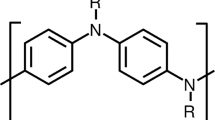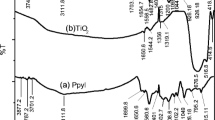Abstract
Density functional theory calculations are performed to evaluate the sensing ability of polypyrrole for oxynitrogen analytes. Interaction energies of PPy-X (X = NO2−, NO2, and NO) are calculated at B3LYP-CP/6-31G(d) and B3LYP/6-31G(d) levels of theory and compared with the high level calibrated method (M05-2X/aug-cc-pVDZ). B3LYP-CP/6-31G(d) gives the best correlation with the high level calibrated method compared to B3LYP/6-31G(d). Interaction of oligopyrrole with analytes shows a significant effect on the geometric and electronic properties; the conjugation is increased in the pyrrole oligomers and movement of charge is increased over the polymeric backbone. The charge is transferred from analytes to pyrrole oligomers (except nPy-NO2), and a more pronounced effect of charge transfer is observed in the case of nitrite ion (NO2−) compared to NO. In nPy-NO2, the charge is transferred from polymer to analyte. This transfer of charge indicates the n-type doping effect of analytes. The HOMO-LUMO gap decreases after interaction with analytes, which results in a drop of resistance (conductivity increases). These theoretical outcomes are consistent with the experimental results; polypyrrole has more sensing ability toward the nitrite anion (NO2−).

High sensitivity of polypyrrole towards NO over NO2 and NO2−










Similar content being viewed by others
References
Gerard M (2002) Application of conducting polymers to biosensors. Biosens Bioelectron 17:345–359
Qu L, Shi G, Yuan J et al (2004) Preparation of polypyrrole microstructures by direct electrochemical oxidation of pyrrole in an aqueous solution of camphorsulfonic acid. J Electroanal Chem 561:149–156
Gracia R, Mecerreyes D (2013) Polymers with redox properties: materials for batteries, biosensors and more. Polym Chem 4:2206
Coakley KM, McGehee MD (2004) Conjugated polymer photovoltaic cells. Chem Mater 16:4533–4542
Cho Y-J, Lim D-H, Jo N-J (2011) Fabrication of ion selective sensor using conducting polymer actuator. Mater Res Innov 15:s59–s62
Lange U, Roznyatovskaya NV, Mirsky VM (2008) Conducting polymers in chemical sensors and arrays. Anal Chim Acta 614:1–26
Peng H, Zhang L, Soeller C, Travas-Sejdic J (2009) Conducting polymers for electrochemical DNA sensing. Biomaterials 30:2132–2148
Baetens R, Jelle BP, Gustavsen A (2010) Properties, requirements and possibilities of smart windows for dynamic daylight and solar energy control in buildings: a state-of-the-art review. Sol Energy Mater Sol Cells 94:87–105
Kulesza PJ, Matczak M, Wolkiewicz A et al (1999) Electrocatalytic properties of conducting polymer based composite film containing dispersed platinum microparticles towards oxidation of methanol. Electrochim Acta 44:2131–2137
AlSalhi MS, Alam J, Dass LA, Raja M (2011) Recent advances in conjugated polymers for light emitting devices. Int J Mol Sci 12:2036–2054
Vernitskaya TV, Efimov ON (1997) Polypyrrole: a conducting polymer; its synthesis, properties and applications. Russ Chem Rev 66:443–457
Ramanavičius A, Ramanavičienė A, Malinauskas A (2006) Electrochemical sensors based on conducting polymer—polypyrrole. Electrochim. Acta 51:6025–6037
Proń A, Kucharski Z, Budrowski C et al (1985) Mössbauer spectroscopy studies of selected conducting polypyrroles. J Chem Phys 83:5923–5927
Kang ET, Ti HC, Neoh KG, Tan TC (1988) ESCA analysis of polymer–acceptor interactions in chemically synthesized Polypyrrole–halogen complexes. Polym J 20:399–406
Schmidt H-L, Gutberlet F, Schuhmann W (1993) New principles of amperometric enzyme electrodes and of reagentless oxidoreductase biosensors. Sensors Actuators B Chem. 13:366–371
George PM, LaVan DA, Burdick JA et al (2006) Electrically controlled drug delivery from biotin-doped conductive Polypyrrole. Adv Mater 18:577–581
Geetha S, Rao CRK, Vijayan M, Trivedi DC (2006) Biosensing and drug delivery by polypyrrole. Anal Chim Acta 568:119–125
Hernandez SC, Chaudhuri D, Chen W et al (2007) Single Polypyrrole nanowire Ammonia gas sensor. Electroanalysis 19:2125–2130
Suri K, Annapoorni S, Sarkar AK, Tandon RP (2002) Gas and humidity sensors based on iron oxide–polypyrrole nanocomposites. Sensors Actuators B Chem 81:277–282
Paul S, Amalraj F, Radhakrishnan S (2009) CO sensor based on polypyrrole functionalized with iron porphyrin. Synth Met 159:1019–1023
Waghuley SA, Yenorkar SM, Yawale SS, Yawale SP (2008) Application of chemically synthesized conducting polymer-polypyrrole as a carbon dioxide gas sensor. Sensors Actuators B Chem. 128:366–373
Kharat HJ, Kakde KP, Savale PA et al (2007) Synthesis of polypyrrole films for the development of ammonia sensor. Polym Adv Technol 18:397–402
Rau J-R, Chen S-C, Sun H-W (1994) Characterization of a polypyrrole microsensor for nitrate and nitrite ions. Electrochim Acta 39:2773–2779
Tu X, Gao Y, Yue R et al (2012) An amperometric nitrate sensor based on well-aligned cone-shaped polypyrrole-nanorods. Anal Methods 4:4182
Navale ST, Mane AT, Chougule MA et al (2014) Highly selective and sensitive room temperature NO2 gas sensor based on polypyrrole thin films. Synth Met 189:94–99
Rad AS, Nasimi N, Jafari M et al (2015) Ab-initio study of interaction of some atmospheric gases (SO2, NH3, H2O, CO, CH4 and CO2) with polypyrrole (3PPy) gas sensor: DFT calculations. Sensors Actuators B Chem 220:641–651
Bibi S, Ullah H, Ahmad SM et al (2015) Molecular and electronic structure elucidation of Polypyrrole gas sensors. J Phys Chem C 119:15994–16003
Sajid H, Mahmood T, Ayub K (2017) An accurate comparative theoretical study of the interaction of furan, pyrrole, and thiophene with various gaseous analytes. J Mol Model 23:295
Sajid H, Mahmood T, Ayub K (2018) High sensitivity of polypyrrole sensor for uric acid over urea, acetamide and sulfonamide: a density functional theory study. Synth Met 235:49–60
Wasim F, Mahmood T, Ayub K (2016) An accurate cost effective DFT approach to study the sensing behaviour of polypyrrole towards nitrate ions in gas and aqueous phases. Phys Chem Chem Phys 18:19236–19247
Zouzelka R, Rathousky J (2017) Photocatalytic abatement of NOx pollutants in the air using commercial functional coating with porous morphology. Appl Catal B Environ 217:466–476
Ogidiama OV, Shamim T (2015) Investigation of dual LayeredSCR systems for NOx control. Energy Procedia 75:2345–2350
Kampa M, Castanas E (2008) Human health effects of air pollution. Environ Pollut 151:362–367
Voskuil MI, Schnappinger D, Visconti KC et al (2003) Inhibition of respiration by nitric oxide induces a Mycobacterium tuberculosis dormancy program. J Exp Med 198:705–713
Crutzen PJ (1970) The influence of nitrogen oxides on the atmospheric ozone content. Q J R Meteorol Soc 96:320–325
Ueda T, Bhuiyan MMH, Norimatsu H et al (2008) Development of carbon nanotube-based gas sensors for NOx gas detection working at low temperature. Physica E 40:2272–2277
Huusko J, Lantto V, Torvela H (1993) TiO2 thick-film gas sensors and their suitability for NOx monitoring. Sensors Actuators B Chem. 16:245–248
Frisch MJ, Trucks GW, Schlegel HB, Scuseria GE, Robb MA, Cheeseman JR, Scalmani G, Barone V, Mennucci B, Petersson GA, Nakatsuji H, Caricato M, Li X, Hratchian HP, Izmaylov AF, Bloino J, Zheng G, Sonnenberg JL, Hada M, Ehara M, Toyota K, Fukuda R, Hasegawa J, Ishida M, Nakajima T, Honda Y, Kitao O, Nakai H, Vreven T, Montgomery JÁ Jr, Peralta JE, Ogliaro F, Bearpark M, Heyd JJ, Brothers E, Kudin KN, Staroverov VN, Kobayashi R, Normand J, Raghavachari K, Rendell A, Burant JC, Iyengar SS, Tomasi J, Cossi M, Rega N, Millam JM, Klene M, Knox JE, Cross JB, Bakken V, Adamo C, Jaramillo J, Gomperts R, Stratmann RE, Yazyev O, Austin AJ, Cammi R, Pomelli C, Ochterski JW, Martin RL, Morokuma K, Zakrzewski VG, Voth GA, Salvador P, Dannenberg JJ, Dapprich S, Daniels AD, Farkas Ö, Foresman JB, Ortiz JV, Cioslowski J, Fox DJ (2010) Gaussian D01. Gaussian Inc., Wallingford
John M, Todd K, Dennington R (2009) GaussView 05. Semichem, Inc., Shawnee Mission
Limas NG, Manz TA (2016) Introducing DDEC6 atomic population analysis: part 2. Computed results for a wide range of periodic and nonperiodic materials. RSC Adv 6:45727–45747
Marinelli F, Dell’Aquila A, Torsi L et al (2009) An organic field effect transistor as a selective NOx sensor operated at room temperature. Sensors Actuators B Chem 140:445–450
Arshad MN, Asiri AM, Alamry KA et al (2015) Synthesis, crystal structure, spectroscopic and density functional theory (DFT) study of N-[3-anthracen-9-yl-1-(4-bromo-phenyl)-allylidene]-N-benzenesulfonohydrazine. Spectrochim Acta Part A Mol Biomol Spectrosc 142:364–374
Rasool N, Kanwal A, Rasheed T et al (2016) One pot selective Arylation of 2-Bromo-5-Chloro Thiophene; molecular structure investigation via density functional theory (DFT), X-ray analysis, and their biological activities. Int J Mol Sci 17:912
Sherzaman S, Sadiq-ur-Rehman AMN et al (2017) Thiobiuret based Ni(II) and co(III) complexes: synthesis, molecular structures and DFT studies. J Mol Struct 1148:388–396
Ahmed MN, Yasin KA, Hameed S et al (2017) Synthesis, structural studies and biological activities of three new 2-(pentadecylthio)-5-aryl-1,3,4-oxadiazoles. J Mol Struct 1129:50–59
Ahmad G, Rasool N, Ikram H et al (2017) Efficient synthesis of novel pyridine-based derivatives via Suzuki cross-coupling reaction of commercially available 5-Bromo-2-methylpyridin-3-amine: quantum mechanical investigations and biological activities. Molecules 22:190
Leenaerts O, Partoens B, Peeters FM (2008) Adsorption of H2O, NH3, CO, NO and NO2 on graphene. Phys Rev B 77:125416
Arshad M, Jadoon M, Iqbal Z et al (2017) Synthesis, molecular structure, quantum mechanical studies and urease inhibition assay of two new isatin derived sulfonylhydrazides. J Mol Struct 1133:80–89
Ahmed MN, Sadiq B, Al-Masoudi NA et al (2018) Synthesis, crystal structures, computational studies and antimicrobial activity of new designed bis((5-aryl-1,3,4-oxadiazol-2-yl)thio)alkanes. J Mol Struct 1155:403–413
Rahman TU, Arfan M, Mahmood T et al (2015) Isolation, spectroscopic and density functional theory studies of 7-(4-methoxyphenyl)-9H-furo[2,3-f]chromen-9-one: a new flavonoid from the bark of Millettia ovalifolia. Spectrochim Acta Part A Mol Biomol Spectrosc 146:24–32
Acknowledgments
The authors acknowledge the Higher Education Commission of Pakistan (Grant No. 3013 and 5309) and COMSATS University, Abbottabad Campus.
Author information
Authors and Affiliations
Corresponding authors
Ethics declarations
Ethical statements
1. The manuscript has not been submitted to more than one journal for simultaneous consideration.
2. The manuscript has not been published previously (partly or in full)
3. A single study is not split up into several parts to increase the quantity of submissions and submitted to various journals or to one journal over time (e.g., “salami-publishing”).
4. No data have been fabricated or manipulated (including images) to support conclusions.
5. No data, text, or theories by others are presented as if they were the author’s own (“plagiarism”) without proper acknowledgements to other’s work if quoted.
Electronic supplementary material
ESM 1
(DOCX 1560 kb)
Rights and permissions
About this article
Cite this article
Wasim, F., Kosar, N., Mahmood, T. et al. Sensor applications of polypyrrole for oxynitrogen analytes: a DFT study. J Mol Model 24, 308 (2018). https://doi.org/10.1007/s00894-018-3843-0
Received:
Accepted:
Published:
DOI: https://doi.org/10.1007/s00894-018-3843-0




